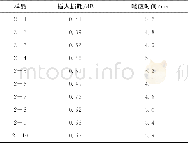《Table 1 Properties of the tested briquette from bituminous coal.》
 提示:宽带有限、当前游客访问压缩模式
提示:宽带有限、当前游客访问压缩模式
本系列图表出处文件名:随高清版一同展现
《Effects of High-temperature Char Layer and Pyrolysis Gas on NOx Reduction in a Typical Decoupling Combustion Coal-fired Stove》
Experiments were carried out using a typical DC stove with a rated thermal power of 10 kW.As shown in Fig.1,the stove mainly consists of a pyrolysis and a combustion chamber as well as a bottom passage between them.The pyrolysis chamber can be further divided into a coal pyrolysis zone and a char combustion zone.Temperatures in five areas of the stove(marked as a to e)are measured simultaneously by multiple thermocouples.Flue gases out of the chimney are on-line analyzed by a flue gas analyzer(ABB AO2020).The stove is generally operated in decoupling mode,in which air is supplied from the bottom inclined grate and flue gas exits at the top of the chimney.As a reference,the DC stove can also be operated in downdraft combustion(DD)mode to simulate the traditional reverse combustion,which is characterized by air supplied from the top of the pyrolysis chamber and flue gas exhausted to the chimney.In the both combustion modes,ellipsoid briquettes from bituminous coal are packed in the pyrolysis chamber at an experimental porosity of 0.45,and the coal bed is ignited from the bottom of the pyrolysis chamber.Main properties of the briquette coal are shown in Table 1.
| 图表编号 | XD0039670800 严禁用于非法目的 |
|---|---|
| 绘制时间 | |
| 作者 | LI Honglin、HAN Jian、ZHANG Nan、LIU Xinhua、HE Jingdong、DU Wei |
| 绘制单位 | State Key Laboratory of Multiphase Complex Systems, Institute of Process Engineering, Chinese Academy of Sciences、State Key Laboratory of Heavy Oil Processing, China University of Petroleum、State Key Laboratory of Multiphase Complex Systems, Institute of |
| 更多格式 | 高清、无水印(增值服务) |





